Technological processes and material science. Рубрика в журнале - Siberian Aerospace Journal
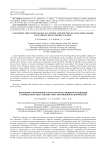
Статья научная
Cation-substituted solid solutions YbXMn1-XS were prepared by the melt method from polycrystalline sulfide powders. The synthesized samples are antiferromagnetic semiconductors and, according to the results of X-ray structural analysis, have an FCC structure of the NaCl type. Structural, electrical, optical, and acoustic properties of the chalcogenide system YbXMn1-XS were studied in the temperature range 80–500 K. The effect of variable valence elements on the electronic structure of cationic substitution of manganese sulfide has been studied. The change in the electronic structure in the YbXMn1-XS system occurs due to the electron-phonon interaction. Samples with variable valence have anomalous compressibility, which is confirmed by the data on the thermal expansion coefficient and the change in the attenuation coefficient. As a result of inelastic interaction with d- electrons, the density of states at the Fermi level changes, this is reflected in the temperature dependence of the conductivity. The positions of the f-level and two electronic transitions were determined from the IR spectra. A zone of temperatures and concentrations was found, where a correlation of structural, electrical, optical and acoustic properties is observed. To explain the experimental results, the electronic structure of the semiconductor is considered and a model is proposed that qualitatively describes the experiment.
Бесплатно
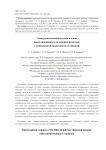
Electrooptical response of the films of polymer dispersed nematic with conical boundary conditions
Статья научная
The electrooptic response of films of polymer dispersed nematic under conical boundary conditions has been investigated. An axial-bipolar director configuration is formed in nematic droplets. It has been shown that initially, the orientation of droplet’s bipolar axes is chaotic both in the sample plane and relative to the normal to the substrates. The applied voltage U orients the droplet’s bipolar axes parallel to the electric field and the reorientation process is threshold only when the bipolar axis is initially orthogonal to the substrate normal. Accordingly, the samples strongly scatter light in the initial state, and the optical response to an electric field is thresholdless. The samples with a film thickness of 5, 10, 20 and 30 μm have been studied. All the samples under study are characterized by a high transmittance and contrast ratio, which for a 30 μm sample are equal to 84 % and 5536, respectively, and achieved at U = 12 V. The results obtained are relevant for use in low-power optoelectronic devices required for the development of energy-saving technologies in aerospace engineering.
Бесплатно
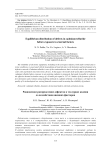
Equilibrium distribution of defects in cadmium telluride before exposure to external factors
Статья научная
The reliability of electronic equipment, including in the aerospace industry, both under normal and extreme conditions, is associated with the degradation of materials due to the formation and development of a defective network. Cadmium telluride is one of the semiconductors that is actively used in the creation of solar cells and modern microelectronic devices. In this paper, the model of the point defects distribution in cadmium telluride before exposure to any ionizing radiation is proposed, that made it possible to calculate the effective thermal activation energy of a Frenkel pair equal to 1.37 eV. Studies of the features of the defects formation and evolution using modeling methods in cadmium telluride, in the future, will improve the quality of its technological use, saving financial resources and increasing the reliability of products.
Бесплатно
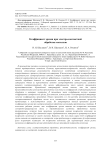
Erosion coefficient in electric contact processing of metals
Статья научная
In the production of rocket and space technology, difficult-to-machine steels and alloys are used by traditional methods. Therefore, electrical methods for processing parts are used that use a variety of thermal effects of an electric current directly in the process of removing a layer of material. In the technology of dimensional electrical processing, the role of electroerosive methods is increasing, which are increasingly used in all branches of mechanical engineering as the most effective, and often, and as the only possible ways of processing parts made of modern high-strength and viscous structural materials. One of the most promising methods of electrical processing of metal blanks is electrocontact. Performance is applied to evaluate the effectiveness of this method. The carried out literary analysis showed that the product of the current strength and the coefficient taking into account the processing mode and the material of the electrodes is used to assess the productivity. Later, this coefficient was called the coefficient of electrical erosion. For metals used in switching equipment, the value of the coefficient is given. However, it cannot be used to calculate the performance of electrical contact processing due to the significant difference in erosion processes occurring in the interelectrode gap. According to the literature data, the erosion coefficient was calculated during electrical contact processing, the results are presented in the table. In several works it is indicated that the erosion coefficient depends on the polarity of the inclusion of the rotating disk electrodes and the workpiece being processed. The data presented are contradictory; therefore, studies were carried out on the influence of the inclusion polarity on the erosion coefficient. With the same grade of the processed material and the rotating disc, the polarity of the inclusion does not matter. It was revealed that for steel grade St.3 the erosion coefficient depends on the voltage on the electrodes and, when approaching the arcing voltage, increases sharply, regardless of the polarity of the inclusion. For stainless steel, a sharp increase in the erosion coefficient is observed only at the straight polarity of the inclusion.
Бесплатно
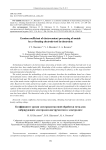
Статья научная
Technological indicators of electrocontact processing of metals with a vibrating electrode-tool in an electrolyte have been studied quite fully. Knowledge of the erosion coefficient of this processing method will allow us to evaluate the performance of electrocontact processing in advance, at the stage of technological preparation of production. The article presents the methodology of the experiment, describes the installation based on a linear electrodynamic motor, which allows you to create a vibration of the electrode-tool and electrolyte flow in the interelectrode gap. The results of experimental studies are shown in the form of a graph of the dependence of the metal erosion coefficient on the water velocity in the interelectrode gap at various current densities. Based on the results and previous studies, it was assumed that the erosion coefficient depends in direct proportion on the voltage in the interelectrode gap and is inversely proportional to the volumetric heat capacity of the metal and its melting temperature. Based on the theory of electrical contacts and taking into account the features of electrocontact processing in the electrolyte, the definition of voltage in the contact zone has been refined. The theoretical value of the erosion coefficient exceeds the experimental value by two or more times.
Бесплатно
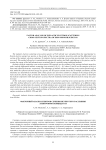
Factor analysis of inelastic electron scattering cross section spectra of iron monosilicide FeSi
Статья научная
The inelastic electron scattering cross-section spectra of FeSi silicide were calculated from the experimental reflected electron energy loss spectra as the product of the average inelastic mean free path and the differential cross section of the inelastic electron scattering. To inelastic electron scattering cross-section spectra study, factor analysis was used. This method allowed us to quantitatively separate the surface and bulk contributions to the spectra, and determine the energy of the bulk plasmon more accurately than it is possible using traditional methods. Inelastic electron scattering cross-section spectra (Kλ-spectra) are the products of the average inelastic mean free path λ and the differential inelastic scattering cross-section K (E0, E0 – E), where E0 and E are the energies of the primary and reflected electrons, respectively. The advantage of inelastic electron scattering cross section spectroscopy is that, unlike the reflected electron energy loss spectra, the Kλ-spectra exclude losses due to multiple excitations, and the intensities are determined in absolute units. These spectra are also more sensitive to changes in the energy of the primary electrons and the angle of emission. Inelastic electron scattering cross-section spectroscopy allows to determine the element composition with much greater accuracy than the traditional method of reflected electron energy loss spectroscopy. In this work, factor analysis is used to study the inelastic electron scattering cross section spectra of the FeSi silicide. This method allowed to solve the actual problem of separating spectra into contributions of a different origin, quantify them and determine the energies of a bulk plasmon more accurately compared with traditional methods. The study of electron energy loss processes by isolating contributions of different origin in the inelastic electron scattering cross section spectra is one of the urgent problems of electron spectroscopy, which can be used to assess the effect of surface excitations in REELS, XPS and AES.
Бесплатно
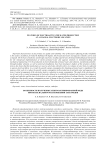
Features of electroactivated water production at a coaxial electrode location
Статья научная
Important characteristics of any product are quality and reliability. One of the factors affecting product reliability is the surface cleanliness provided by flushing with liquids. Electroactivated water and aqueous solutions can be used as liquids. On the basis of domestic and foreign experience, leading experts have developed methodological instructions for the widespread implementation of electro-activated water and aqueous solutions in instrument-making and mechanical engineering. For the production of electrochemically activated water and solutions, non-flowing and flowthrough modular elements, as well as universal installations, have been developed. Analysis of the structures of these devices has shown that flat metal plates are used as electrodes, therefore there are volumes of water that are subjected to uneven electrical effects. As a result, the specific energy consumption for obtaining activated water is significant. The purpose of the work is to reduce the specific energy consumption in the production of activated water and aqueous solutions. Coaxial arrangement of the electrodes leads to reduction in energy consumption. The study of the electroactivator of water with a coaxial arrangement of electrodes allowed us to establish the optimal ratio between the volumes of anolyte and catholyte and the time of electrolysis of water and an aqueous solution of sodium chloride. A new indicator of efficiency (the specific energy consumption per unit of change in the pH of water or an aqueous solution) objectively reflects the perfection of the design of electroactivators. The research results can be used in instrument and mechanical engineering.
Бесплатно
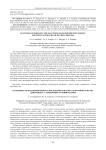
Features of modeling the electron beam distribution energy for the electron-beam welding process
Статья научная
The energy distribution of the electron beam by means of application of various scanning paths, affects for-mation of the weld, which relates to the quality of the welded joints. Experimental studies, conducted by the au-thors of the article showed that scanning the electron beam in the form of a raster shape gives the best quality of welded joints; therefore, the trajectories of a classical raster and a truncated raster are proposed for the elec-tron beam welding process. When conducting research in this direction, the authors discovered the following regularity: with an increase in the scanning amplitude along the junction, the vapour-gas penetration channel transforms into a stable cavity, along the front wall of which the metal melts, and along the side walls it is trans-ferred to the tail of the weld pool. The discovered effect of the formation of a penetration cavity is to be investigated in electron beam welding of various materials and thicknesses. For this the necessary equipment is to be created, allowing to make scan-ning in the form of various rasters. To improve the quality of the electron beam welding process, trajectories of a classical raster and a truncated raster across the joint are proposed. For these scanning trajectories, analytical expressions and families of calculated characteristics of the electron beam energy density distribution over the heating spot are obtained. Modulation of the electron beam oscillation in the form of a truncated raster across the junction makes it possible to obtain a two-humped distribution of the beam energy on the surface of the part along the heating spot. The obtained characteristics allow a more meaningful approach to optimizing the pro-cess of electron beam welding of various materials.
Бесплатно
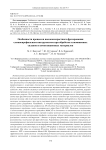
Статья научная
Complex computational and experimental studies substantiate rational modes of milling of complex contour equiaxed surfaces with high accuracy of shape, dimensions and roughness parameters. Bars made of nanostructured carbide composite (produced by extrusion of WC-Co-Al2O3 bimodal powder mixtures) with increased strength, crack resistance and heat resistance were used as a workpiece material for the manufacture of new original tool designs. The combination of these properties is a necessary prerequisite for the effective operation of the developed designs of multi-blade cutters at high cutting speeds and under conditions of variable cyclic loads. A more complex kinematics of the joint rotational movement of the tool during milling dictates the need for new approaches when assigning rational cutting modes. To obtain reliable calculation formulae, numerical experiments were previously carried out, including simulation of the machining process using the VisualStudio integrated development environment, which supports Windows- Forms technology. The ability to display graphical 3D objects was implemented using an additional software product in the form of the Open CASCADE geometric core. Numerical experiments using MathCAD software products and based on the analytical provisions proposed in the work made it possible to evaluate the influence of cutting conditions, geometric parameters of the cutting part of the tool (profile and number of teeth), kinematics of relative movement in the “tool – part” system on the shape of surfaces and contour parameters (roughness) obtained during milling. A technique, algorithm and program for the automated calculation of cutting conditions have been developed, which have been verified during full-scale experiments and the manufacture of complex profile parts from aluminum alloys for drives of aerospace products (in the form of an equiaxial profile and parts of a pinion transmission of guidance mechanisms). At the same time, on the basis of a 3D model of products, control programs for CNC machines were created using MasterCAM. The practical significance and technical and economic efficiency of the proposed design and technological solutions is to increase productivity and reduce the complexity of processing (in comparison with the basic options) through the use of new multi-edge carbide tools for high-speed milling (including when processing composite materials).
Бесплатно

Flexible composite structures with controlled physical and mechanical characteristics
Статья научная
The article presents the results of theoretical and experimental studies that are the basis for the devel-opment of a new class of aerospace engineering structures that allow implementing approaches to create structures with variable morphological and functional characteristics of products. Condensed soft sub-stances, such as elastomers, gels, gradually become functional elements on the basis of which the creation of soft machines and electronics develops [1–3]. Research in this direction has led to the creation of struc-tures with a special architecture that are mechanically compatible, deformable and capable, with a certain combination, of perceiving and transmitting a signal, changing their shapes and physical characteristics (thermal conductivity, electrical conductivity, etc.). The use of such structures in a certain sense models the multifunctionality observed in biological objects and structures (skin, muscles, nervous tissue) [4–7]. The creation of structures that change their shape, structure and change their functional and operational char-acteristics in the process of work, taking into account changing external and internal conditions, is an ur-gent task for many systems of aerospace technology. In this paper, morphologically changeable structures are considered, which include reconfigurable antennas, aircraft wings with variable shape and geometry, flexible robotic systems [8]. The use of such systems with flexible structural elements makes it possible to create structures capable of overcoming unpredictable obstacles due to their adaptive geometry, fit into limited spaces and withstand significant loads and vibrations. One of the most important tasks in the devel-opment of such systems is the organization of a distributed actuation system associated with the problem of creating an internal structure of actuators integrated into a flexible composite design of actuators made of elastic materials. In a number of works for the operation of thermoactive actuators, the use of rigid nano-particles as surface heating elements or as fillers for composites that are electrically sensitive, magnetical-ly sensitive and/or photoreactive has been investigated [9–13]. However, surface heating elements are lim-ited in use beyond a thickness of several hundred micrometers due to their low intrinsic thermal conductivi-ty [14]. In addition, rigid components significantly change the mechanical properties of the structure being created, which limits the morphological capabilities of the structures being created. For example, in [15], it is shown that reducing the electrical resistance for a thermal heater to acceptable values requires an increase in the filler to 15% of the mass of the structure, while the deformation of the actuation of the struc-ture is reduced by 35.0%. In this paper, overcoming the above limitations is carried out by creating a ma-terial architecture that dramatically expands the range of properties and dynamic functions of the heating element being developed for the actuator. Multifunctionality is achieved by embedding metal fibers of a certain configuration into an elastic medium based on polydimethylsiloxane elastomer, which provide mo-bility and conformality of the deformable structure of the actuator during its operation. It is shown that the inclusion of metal fibers of a certain configuration in the structure of the actuator does not interfere with its ability to change shape and perform mechanical work in response to external stimuli. Shape morphing in the absence of an external load can be programmed in the composite structure by including fibers with certain stiffness and thermal characteristics in it so that it can reversibly switch between programmed morphologies using electrical or thermal stimulation. Together, these properties allow the composite to demonstrate a rich variety of functionality, which allows it to simultaneously realize sensory and dynamic characteristics.
Бесплатно
![Formation features of the central layers of the alloy Fe – 3 % Si (110)[hkl] rolling textures Formation features of the central layers of the alloy Fe – 3 % Si (110)[hkl] rolling textures](/file/thumb/148321699/formation-features-of-the-central-layers-of-the-alloy-fe-3-si-110-hkl.png)
Formation features of the central layers of the alloy Fe – 3 % Si (110)[hkl] rolling textures
Статья научная
The fields of solid-state physics, metallurgy, plastic deformation, mathematics and continuum mechanics are engaged in the studies of texturing of metals and alloys and their influence on the operational properties of products. As a rule, the most significant results are expected at the interface between these sciences. The technologies of obtaining textured materials by metal forming processes occupy a special place in the metalworking sphere. This is due to promising directions in technologies for producing semi-finished and final products with improved structure-sensitive properties, by regulating the texturing, taking into account initial crystallographic orientation of the workpiece. The first issue to note is the formation of an ideal, one-component crystallographic texture in anisotropic metallic materials. The second issue is to obtain semi-finished and final products with more specific service properties: crystallographic texture with specific predetermined components. For instance, due to the crystallographic texture, it is possible to increase the resistance of metals and alloys against corrosion and hostile environment. Considering textured materials as composite, we must note that directionally oriented crystallites with crystallographic directions relative to the laboratory direction perform as reinforced elements. The initial texture in the processing plane is especially important. The materials, which possess unique structure-sensitive properties acquired through pressure treatment, are very promising for a widespread use in the sphere of aerospace technology. Obviously, the properties and means of their achievement are diverse and require setting a specific task. Therefore, further research in this sphere is especially promising. The article presents the research findings, considering the effect of initial crystallographic orientation and deformation modes on the rolling texture in the central layer of Fe – 3% Si (110)[hkl] single crystals. Several groups of single crystal samples underwent rolling under laboratory conditions. The groups of samples were classified according to the final deformation rate, the ideal crystallographic orientation of the rolling plane and deflections of the ideal orientation plane direction from the rolling direction. The methodology of the experiment took into account the compression rate value during one rolling. We analyzed the results of rolling, using the radiographic method. The next step was to superimpose the radiographic data on a stereographic projection and to construct straight pole figures. The results of straight pole figures decoding revealed differences in the texture formation from the previously obtained data. The research shows the manifestation of the one-component deformation texture in the central layer.
Бесплатно

Статья научная
The purpose of this work is to detect the regularities of formation of the structure, mechanical and tribological properties of high-chromium steel subjected to complex treatment combining irradiation with a pulsed electron beam and subsequent nitriding in a low-pressure gas discharge plasma using a plasma generator with an incandescent cathode “PINK”. The object of the study was heat-resistant corrosionresistant austenitic steel grade AISI 310S. The relevance and practical significance of the research is due to the relatively low level of hardness and wear resistance of steels of this class, which have a wide range of applications in modern industry, including in the rocket and space industry. Irradiation of AISI 310S steel with a pulsed electron beam was carried out at the SOLO installation, subsequent nitriding (the QUINTA installation). It was found that irradiation of samples at an electron beam energy density of 30 J/cm2, 200 microseconds, 3 pulses and subsequent nitriding at a temperature of 793 K for 3 hours led to the following changes in mechanical properties. The maximum microhardness reached values of 19 GPa (exceeds the hardness of steel before modification by 11.2 times and the hardness of steel after electron beam irradiation by 8 times). The wear parameter has changed to values k = 0.7106 mm3/Nm (less than the wear parameter of steel before modification by more than 700 times and less than the wear parameter of steel after electron beam irradiation by more than 750 times). The thickness of the hardened layer is 40 microns. It was found that the samples that have the maximum (90.6 %) content of nitride phases (chromium and iron nitrides) in the surface layer. It was established that after nitriding at a temperature of 723 K in the surface layer of steel, iron and chromium nitrides are formed in the form of nanoscale particles of rounded shape. At nitriding temperatures of 793 and 873 K, a plate-type structure formed by alternating parallel plates of iron nitride and chromium nitride is formed in the surface layer of steel.
Бесплатно
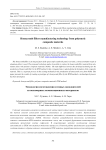
Honeycomb fillers manufacturing technology from polymeric composite materals
Статья научная
The honeycomb filler is an integral part of the spacecraft's sandwich panel. Currently, a honeycomb filler made of aluminum alloys is used. The proposed technology makes it possible to replace the honeycomb filler material from aluminum alloys with polymer composite materials (PCM). The main difference between the developed technology for the production of honeycomb filler by the RTM method is that corrugated tape is glued during the formation of the composite material. This is a separate process in the existing methods for the production of honeycomb cores from PCM. This paper presents the results of creating a prototype of a honeycomb filler by the RTM-method, a technological process has been developed.
Бесплатно
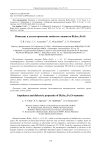
Impedance and dielectric properties of Bi2Sn2-xFexO7 stannates
Статья научная
Bismuth stannates Bi2Sn2–хFeхO7, х = 0,1; 0,2, which reveal the properties of multiferroics, are investigated. The mechanism of interaction between dielectric and electronic subsystems is studied, based on measurements of electrical resistance at alternating current, impedance, capacitance and dielectric loss tangent in the temperature range 100–600 K at frequencies 102–106 Hz. From the comparison of dielectric permittivity and the reactive component of impedance, the paramagnetic contribution of electrons to the dynamic magnetic susceptibility was established. Impedance jumps on temperature were detected as a result of changes in structural characteristics. The temperature dependences of the permittivity are described in the Debye model. The activation character of relaxation time and two relaxation channels are found. The activation energy of electrons in the migratory polarization is calculated.
Бесплатно
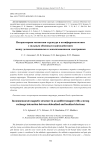
Статья научная
The formation of an incommensurate three-dimensional magnetic order in an antiferromagnet as a re-sult of a strong correlation between holes and localized spins is studied. The spectrum of spin polarons, the spin density wave, and the wave vector of the structure are calculated in the Kondo lattice model. The magnetic system is considered in the adiabatic approximation, the sublattice magnetization and spin-spin correlation functions are presented in the mean-field approximation. The Fermi energy and s – d interaction energy are calculated. The heat capacity and heat capacity anomalies due to spin polarons are determined. Anomalies in the temperature dependence of conductivity and in optical conductivity in the lowenergy region are found.
Бесплатно
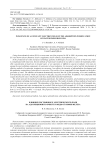
Influence of a constant electric field on the adsorption purification of water from iron ions
Статья научная
Using electrochemical action (ECA) to treat water was first proposed in UK in 1889. At present, many methods of ECA are known (electro flotation, electro coagulation, electro osmosis, electrophoresis, etc.). In the production of rocket and space technology, galvanic technologies are used, as a result of which waste water is contaminated with metal ions. Known methods of wastewater treatment do not allow to ensure the maximum permissible concentration of metal ions in treated water, or are expensive or difficult to operate in industry. Iron ions are among the most polluting components of wastewater of most industries. So increased control and the development of effective methods of wastewater treatment are necessary. Iron affects the intensity of phytoplankton development and the qualitative composition of microflora in reservoirs. The toxicity of iron compounds in water depends on the hydrogen index of water. The alkaline environment dramatically increases the risk of fish poisoning, as in such conditions, iron hydroxides are formed, which are deposited on the gills, clog and corrode them. In addition, iron compounds bind oxygen dissolved in water, which leads to the mass death of fish and other hydrobionts. The article presents the method of conducting experiments, the methods of sorption, electrochemical and combined water treatment, including electrochemical action and adsorption. The results of studies of these methods of water purification from iron ions are presented. The dependence of the degree of purification on the electric field strength, interelectrode distance and water treatment time is revealed. With an electric field strength of 5.16 V/mm, a temperature of 20–22 °C using quartz sand as an adsorbent and a processing time of 1 minute, the concentration of iron ions decreased from 2.5 to 0.25 mg/l (at MPC = 0.3 mg/l). The proposed combined cleaning method requires inexpensive and affordable materials and is easy to operate.
Бесплатно
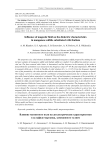
Статья научная
The properties of a solid solution of thulium-substituted manganese sulfide prepared by melting the ini-tial pure samples of manganese sulfide and thulium sulfide are studied. X-ray diffraction analysis was car-ried out. The face-centered cubic lattice is determined, and the decrease in the intensity of the peaks is found. Dielectric permittivity was measured in the frequency range 102–106 Hz and temperatures 300–500 K in magnetic fields up to 12 kOe in TmxMn1-xS solid solutions (0 < x < 0.15). From the frequency depend-ence of the permittivity, the relaxation time and the relaxation mechanism of the dipole moments are found. The leakage current is excluded, and the contribution of migration polarization due to charges in the re-gion with chemical phase separation is estimated. The real and imaginary components of the permittivity of TmxMn1-xS samples are described in the Debye model. The maximum of the imaginary component of the permittivity shifts towards higher frequencies upon heating, and the relaxation time is described by the Ar-rhenius function. Dielectric losses are caused by electron-phonon interaction. The frequency of the crosso-ver from Debye relaxation to relaxation conduction associated with the absorption and emission of pho-nons is found. The crossover frequency increases as the sample is heated according to a power law. In a magnetic field, the permittivity decreases and the largest change of 2.5 % is achieved at T = 450 K. At oth-er temperatures, the magnetocapacitance does not exceed 0.5 %. The shift of the maximum of the imagi-nary component of the permittivity to low frequencies in a magnetic field leads to a change in the sign of dielectric losses from positive to negative. A qualitative difference in ε(ω) is established in the vicinity of the concentration of thulium ion flow through the FCC lattice, where the permittivity is not described in the Debye model and there is no magnetocapacitance. The mechanism for reducing dielectric losses in a mag-netic field is determined.
Бесплатно
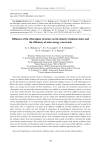
Статья научная
Due to the absorption of solar energy in chloroplasts – green plastids, solar energy is converted into the energy of chemical bonds. Studying the processes of photosynthesis and increasing its efficiency is relevant for the development of closed life support systems, during long flights in space as well. Chloroplasts are filled with stacks of highly ordered thylakoid membranes (grana). Pigment-protein photosynthetic complexes are located on the border of these membranes. For a long time, the structural characteristics of chloroplasts were not given due attention and they were studied as isotropic substances, but in recent years it has been shown that they have anisotropic properties and a high conversion coefficient during charge separation. In this work, an approach was proposed for a more accurate spatial determination of grana in plant chloroplasts and for determining the size of a single unit. Thylakoid membranes and the boundaries of the facet consisting of them are clearly visible in an electron microscope if the electron beam is directed strictly perpendicularly. It was noticed that when the stage is rotated, different regions of the membranes become either blurred or more distinct, which suggests that the grana in chloroplasts are not located in the same plane. Also, a comparison was made of the influence of different external conditions on the chloroplast structure of a plant, not only through a comparison of morphological characteristics, but also through numerical modeling and comparison of the objects spectral properties. For numerical simulation, periodic lattices were determined for the main structural units of chloroplasts of different samples. On the basis of these gratings, the transmission spectra were calculated using the transfer matrix method. Also, the obtained values of the electromagnetic wave along the lattice made it possible to calculate the graphs of the density of photon states. The results of the calculation method of plots of the density of photon states based on the structure of chloroplasts made it possible not only to assess the possible efficiency of photosynthesis, but also to directly relate these models to the external conditions affecting the plant.
Бесплатно
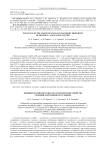
Influence of the magnetic field on transport properties of holmium – manganese sulfide
Статья научная
Holmium-manganese sulfide with giant magnetoresistance refers to new magnetic sulfide compounds of holmium and manganese that have the effect of giant magnetoresistance (i. e., with special magnetoelectric properties), which can be used as components of sensor technology, magnetic memory, and spintronics. The technology of manufacturing polycrystals HoXMn1-XS grown by crystallization from the melt of the obtained powdered sulfides with a purity not lower than 99,9 %, in glass-carbon crucibles and a quartz reactor in an argon atmosphere is presented. According to the results of x-ray diffraction analysis, HoXMn1-XS holmium-manganese sulfides have a HCC structure of the NaCl type. As the degree of cationic substitution increases, the unit cell parameter increases linearly with the concentration. No concomitant impurity phases are detected in the synthesized samples. To determine the state of the spin glass, magnetic moment measurements are conducted at several frequencies ω = 1 kHz, 10 kHz and 100 kHz. The dependence of magnetic characteristics on the frequency of measurements is found. The damping of the magnetic moment and its increase with a decrease in temperature is reviled, which is connected with the formation of metastable States. Measurements of electrical resistance without a field and in a magnetic field are conducted. Anomalies in the temperature dependence of the conductivity are found. A change in the magnetoresistance sign is detected with the increase of temperature below and above room temperature.
Бесплатно
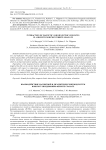
Interaction of magnetic and dielectric subsystes in a bismuth nodymic ferrite-granate
Статья научная
Bismuth-substituted ferrite garnets possess magneto-optical (MO) properties and are used as spatial light modulators and indicators. The paper studies the influence of magnetic and electric fields on the structural characteristics of thin epitaxial films of bismuth-neodymium ferrite garnet (Bi: NIG) deposited on glass and gallium gadolinium garnet (GGG) substrates. Dynamic properties of polarization, relaxation in a magnetic and electric field are considered, which is an important task for getting a deep insight into the mechanisms of electromagnetic phenomena in solids. Dependence of the magnetostriction coefficient on the magnetic field and dependence of a relative change in the length of the film on the electric field at different temperatures are obtained. A change in the sign of magnetostriction constants with respect to temperature was found. The electric polarization in a periodically applied electric field of 400 V / cm with a frequency of 10 MHz is determined for various magnetic field orientations of 12 kOe and in the absence of a magnetic field. Anisotropy of polarization in a magnetic field and a functional dependence of the polarization relaxation on time are found. These materials can be used as sensors of the magnetic field in a spacecraft.
Бесплатно

